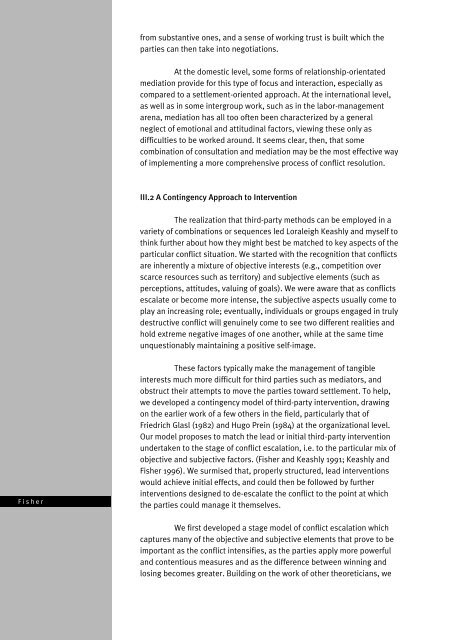Methods of Third-Party Intervention - Berghof Handbook for Conflict ...
Methods of Third-Party Intervention - Berghof Handbook for Conflict ...
Methods of Third-Party Intervention - Berghof Handbook for Conflict ...
Create successful ePaper yourself
Turn your PDF publications into a flip-book with our unique Google optimized e-Paper software.
Fisher<br />
from substantive ones, and a sense <strong>of</strong> working trust is built which the<br />
parties can then take into negotiations.<br />
At the domestic level, some <strong>for</strong>ms <strong>of</strong> relationship-orientated<br />
mediation provide <strong>for</strong> this type <strong>of</strong> focus and interaction, especially as<br />
compared to a settlement-oriented approach. At the international level,<br />
as well as in some intergroup work, such as in the labor-management<br />
arena, mediation has all too <strong>of</strong>ten been characterized by a general<br />
neglect <strong>of</strong> emotional and attitudinal factors, viewing these only as<br />
difficulties to be worked around. It seems clear, then, that some<br />
combination <strong>of</strong> consultation and mediation may be the most effective way<br />
<strong>of</strong> implementing a more comprehensive process <strong>of</strong> conflict resolution.<br />
III.2 A Contingency Approach to <strong>Intervention</strong><br />
The realization that third-party methods can be employed in a<br />
variety <strong>of</strong> combinations or sequences led Loraleigh Keashly and myself to<br />
think further about how they might best be matched to key aspects <strong>of</strong> the<br />
particular conflict situation. We started with the recognition that conflicts<br />
are inherently a mixture <strong>of</strong> objective interests (e.g., competition over<br />
scarce resources such as territory) and subjective elements (such as<br />
perceptions, attitudes, valuing <strong>of</strong> goals). We were aware that as conflicts<br />
escalate or become more intense, the subjective aspects usually come to<br />
play an increasing role; eventually, individuals or groups engaged in truly<br />
destructive conflict will genuinely come to see two different realities and<br />
hold extreme negative images <strong>of</strong> one another, while at the same time<br />
unquestionably maintaining a positive self-image.<br />
These factors typically make the management <strong>of</strong> tangible<br />
interests much more difficult <strong>for</strong> third parties such as mediators, and<br />
obstruct their attempts to move the parties toward settlement. To help,<br />
we developed a contingency model <strong>of</strong> third-party intervention, drawing<br />
on the earlier work <strong>of</strong> a few others in the field, particularly that <strong>of</strong><br />
Friedrich Glasl (1982) and Hugo Prein (1984) at the organizational level.<br />
Our model proposes to match the lead or initial third-party intervention<br />
undertaken to the stage <strong>of</strong> conflict escalation, i.e. to the particular mix <strong>of</strong><br />
objective and subjective factors. (Fisher and Keashly 1991; Keashly and<br />
Fisher 1996). We surmised that, properly structured, lead interventions<br />
would achieve initial effects, and could then be followed by further<br />
interventions designed to de-escalate the conflict to the point at which<br />
the parties could manage it themselves.<br />
We first developed a stage model <strong>of</strong> conflict escalation which<br />
captures many <strong>of</strong> the objective and subjective elements that prove to be<br />
important as the conflict intensifies, as the parties apply more powerful<br />
and contentious measures and as the difference between winning and<br />
losing becomes greater. Building on the work <strong>of</strong> other theoreticians, we

















